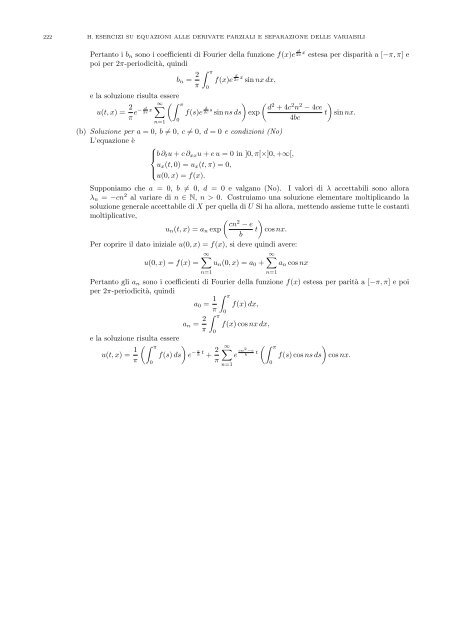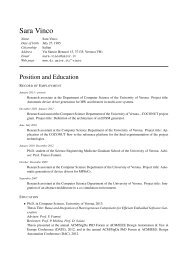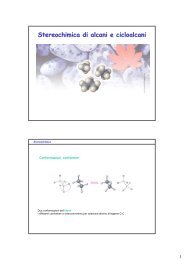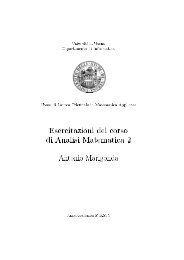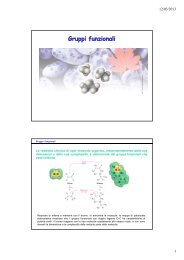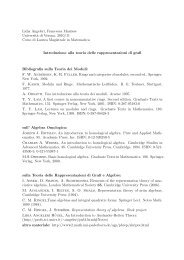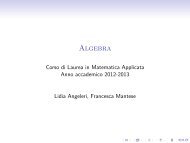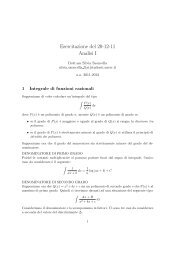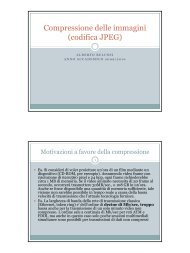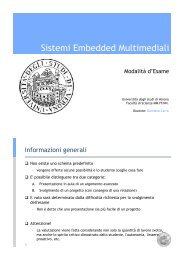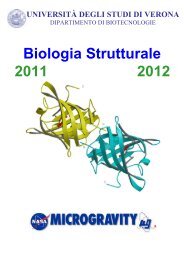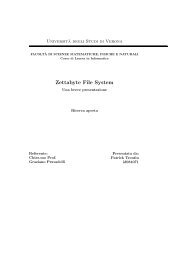- Page 1:
Università di Verona Facoltà di S
- Page 4 and 5:
iv INDICE Capitolo 18. Lezione del
- Page 7 and 8:
CAPITOLO 1 Lezione del giorno giove
- Page 9 and 10:
CAPITOLO 2 Lezione del giorno vener
- Page 11:
2. ALCUNE NOZIONI DI TOPOLOGIA DI R
- Page 14 and 15:
10 3. LIMITI DELLE FUNZIONI IN PIÙ
- Page 17 and 18:
CAPITOLO 4 Lezione del giorno giove
- Page 19 and 20:
Tale limite dipende da m > 0, perta
- Page 21 and 22:
CAPITOLO 5 Lezione del giorno marte
- Page 23 and 24:
CAPITOLO 6 Lezione del giorno giove
- Page 25 and 26:
6. SUCCESSIONI E CONVERGENZA UNIFOR
- Page 27:
6. SUCCESSIONI E CONVERGENZA UNIFOR
- Page 30 and 31:
26 7. SERIE DI FUNZIONI pertanto la
- Page 33 and 34:
CAPITOLO 8 Lezione del giorno giove
- Page 35 and 36:
8. DIFFERENZIALI PER FUNZIONI DI PI
- Page 37 and 38:
8. DIFFERENZIALI PER FUNZIONI DI PI
- Page 39 and 40:
CAPITOLO 9 Lezione del giorno marte
- Page 41 and 42:
9. MASSIMI E MINIMI PER FUNZIONI DI
- Page 43:
9. MASSIMI E MINIMI PER FUNZIONI DI
- Page 46 and 47:
42 10. MASSIMI E MINIMI PER FUNZION
- Page 48 and 49:
44 10. MASSIMI E MINIMI PER FUNZION
- Page 50 and 51:
46 11. MASSIMI E MINIMI PER FUNZION
- Page 52 and 53:
48 12. MASSIMI E MINIMI VINCOLATI P
- Page 55 and 56:
CAPITOLO 13 Lezione del giorno mart
- Page 57:
13. TEOREMA DELLA FUNZIONE IMPLICIT
- Page 60 and 61:
56 14. TEOREMA DELLA FUNZIONE IMPLI
- Page 62 and 63:
58 14. TEOREMA DELLA FUNZIONE IMPLI
- Page 64 and 65:
60 14. TEOREMA DELLA FUNZIONE IMPLI
- Page 67 and 68:
CAPITOLO 15 Lezione del giorno mart
- Page 69:
B a C. Si ha allora: I = = 1 4−
- Page 72 and 73:
68 16. INTEGRALI MULTIPLI - CONTINU
- Page 74 and 75:
70 16. INTEGRALI MULTIPLI - CONTINU
- Page 76 and 77:
72 16. INTEGRALI MULTIPLI - CONTINU
- Page 78 and 79:
74 17. PREPARAZIONE ALLA PRIMA PROV
- Page 80 and 81:
76 17. PREPARAZIONE ALLA PRIMA PROV
- Page 82 and 83:
78 17. PREPARAZIONE ALLA PRIMA PROV
- Page 84 and 85:
80 17. PREPARAZIONE ALLA PRIMA PROV
- Page 86 and 87:
82 17. PREPARAZIONE ALLA PRIMA PROV
- Page 88 and 89:
84 18. INTEGRALI CURVILINEI, FORMUL
- Page 91 and 92:
CAPITOLO 19 Lezione del giorno giov
- Page 93 and 94:
e d’altra parte: 19. INTEGRALI CU
- Page 95 and 96:
19. INTEGRALI CURVILINEI, TEOREMA D
- Page 97 and 98:
CAPITOLO 20 Lezione del giorno giov
- Page 99 and 100:
20. PRIMA PROVA IN ITINERE 95 2. Vi
- Page 101 and 102:
20. PRIMA PROVA IN ITINERE 97 g2(θ
- Page 103 and 104:
20. PRIMA PROVA IN ITINERE 99 Svolg
- Page 105 and 106:
CAPITOLO 21 Lezione del giorno mart
- Page 107 and 108:
21. INTEGRALI CURVILINEI, TEOREMA D
- Page 109 and 110:
21. INTEGRALI CURVILINEI, TEOREMA D
- Page 111:
21. INTEGRALI CURVILINEI, TEOREMA D
- Page 114 and 115:
110 22. FORME DIFFERENZIALI Teorema
- Page 116 and 117:
112 22. FORME DIFFERENZIALI b) Per
- Page 118 and 119:
114 22. FORME DIFFERENZIALI b) Affi
- Page 120 and 121:
116 22. FORME DIFFERENZIALI Quindi
- Page 123 and 124:
CAPITOLO 23 Lezione del giorno giov
- Page 125 and 126:
23. EQUAZIONI TOTALI E EQUAZIONI DI
- Page 127 and 128:
23. EQUAZIONI TOTALI E EQUAZIONI DI
- Page 129 and 130:
CAPITOLO 24 Lezione del giorno mart
- Page 131 and 132:
CAPITOLO 25 Lezione del giorno giov
- Page 133 and 134:
25. EQUAZIONI RICONDUCIBILI AD EQUA
- Page 135 and 136:
25. EQUAZIONI RICONDUCIBILI AD EQUA
- Page 137 and 138:
CAPITOLO 26 Lezione del giorno mart
- Page 139 and 140:
Esercizio 26.2. Dato il problema di
- Page 141 and 142:
CAPITOLO 27 Lezione del giorno merc
- Page 143 and 144:
27. SERIE DI FOURIER E METODO DI SE
- Page 145 and 146:
27. SERIE DI FOURIER E METODO DI SE
- Page 147:
27. SERIE DI FOURIER E METODO DI SE
- Page 150 and 151:
146 28. METODO DI SEPARAZIONE DELLE
- Page 152 and 153:
148 28. METODO DI SEPARAZIONE DELLE
- Page 154 and 155:
150 28. METODO DI SEPARAZIONE DELLE
- Page 156 and 157:
152 29. ESERCIZI RICAPITOLATIVI (2)
- Page 158 and 159:
154 29. ESERCIZI RICAPITOLATIVI oss
- Page 160 and 161:
156 29. ESERCIZI RICAPITOLATIVI 3 2
- Page 162 and 163:
158 30. ESERCIZI RICAPITOLATIVI - C
- Page 164 and 165:
160 30. ESERCIZI RICAPITOLATIVI - C
- Page 166 and 167:
162 31. ESERCIZI RICAPITOLATIVI - C
- Page 168 and 169:
164 31. ESERCIZI RICAPITOLATIVI - C
- Page 171 and 172:
CAPITOLO 32 Miscellanea di Esercizi
- Page 173 and 174:
(12) Calcolare il seguente integral
- Page 175 and 176: 32. MISCELLANEA DI ESERCIZI SUPPLEM
- Page 177 and 178: 32. MISCELLANEA DI ESERCIZI SUPPLEM
- Page 179 and 180: 32. MISCELLANEA DI ESERCIZI SUPPLEM
- Page 181 and 182: 32. MISCELLANEA DI ESERCIZI SUPPLEM
- Page 183: 32. MISCELLANEA DI ESERCIZI SUPPLEM
- Page 186 and 187: 182 A. STUDIO DI FUNZIONI IMPLICITA
- Page 188 and 189: 184 A. STUDIO DI FUNZIONI IMPLICITA
- Page 190 and 191: 186 B. ESERCIZI SU FLUSSI, CIRCUITA
- Page 192 and 193: 188 B. ESERCIZI SU FLUSSI, CIRCUITA
- Page 194 and 195: 190 C. RICHIAMI SULLE EQUAZIONI DIF
- Page 197 and 198: APPENDICE D Equazioni differenziali
- Page 199 and 200: D. EQUAZIONI DIFFERENZIALI TOTALI 1
- Page 201: D. EQUAZIONI DIFFERENZIALI TOTALI 1
- Page 204 and 205: 200 E. RICHIAMI SULLE EQUAZIONI DIF
- Page 206 and 207: 202 E. RICHIAMI SULLE EQUAZIONI DIF
- Page 208 and 209: 204 E. RICHIAMI SULLE EQUAZIONI DIF
- Page 210 and 211: 206 E. RICHIAMI SULLE EQUAZIONI DIF
- Page 213 and 214: APPENDICE F Altre equazioni ordinar
- Page 215 and 216: F. ALTRE EQUAZIONI ORDINARIE E METO
- Page 217: F. ALTRE EQUAZIONI ORDINARIE E METO
- Page 220 and 221: 216 G. SISTEMI 2 × 2 DI EQUAZIONI
- Page 223 and 224: APPENDICE H Esercizi su equazioni a
- Page 225: H. ESERCIZI SU EQUAZIONI ALLE DERIV
- Page 229 and 230: I. FUNZIONI TRIGONOMETRICHE ED IPER
- Page 231: I. FUNZIONI TRIGONOMETRICHE ED IPER


